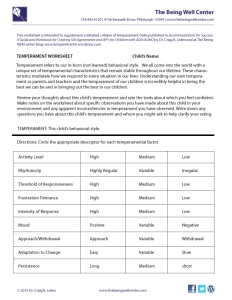A key goal in effective treatment for Attention Deficit Disorder should be to understand our temperament and the temperament of the children we live and work with.
Understanding the concept of temperament and applying that knowledge to ourselves as parents and teachers and to those around us helps us to better understand behavior…struggles, failures, and successes.
Understanding INTENSITY
Intensity of Response refers to the strength of our responses ranging from high to low. These responses can be demonstrated outwardly or experienced inwardly. So it is not always easy to judge someone’s intensity of response by what we see.
Our intensity is independent of the quality (negative or positive) of our response and the immediacy of our response (threshold).
Those of us with a high intensity of response experience or show strong responses. When we are happy we are very, very happy; when we are sad, we are very, very sad; when we are angry, we are very, very angry. Others of us who have a low intensity of response barely show a blip on the screen when our emotions are set off.
A child with high intensity may become overly silly at birthday celebrations, rageful during a conflict on the playground, and immobilized with nervousness on math time-tests.
On the other hand, the child with low intensity of response may not seem to react at all; she does not experience extreme excitement over a special event or intense disappointment over a failure.
In fact, we may find it difficult to read the reactions of a child with low intensity, often misjudging low intensity for not caring.
It is important to remember that when observing for intensity of response, we can’t always judge the book by looking at the cover; some very intense people experience all their intensity internally; nail-biting, skin-picking, complaints of a tightness in one’s chest, stomachaches, jaw aches, or headaches, etc., may be our only clues to what is going on inside.
High intensity of response (externally or internally) is a very powerful temperamental trait. When present, it can rule over everything: good thinking, paying attention, proper self-control, and appropriate social skills to name a few.
Failure to identify a high intensity response pattern and appropriately accommodate for it can, inadvertently, set a child up for turning to a variety of other dysfunctional behaviors in an attempt to cope with her strong reactions including such things as over-eating, drug use, and developing an “I don’t care” attitude.
 Upcoming blog posts will discuss the other 9 Temperamental Traits that make you and your child unique. Follow along with this Being Well Center | Temperament Worksheet designed to help you pinpoint where your or your child’s temperament trait falls on the continuum. Catch up on previous posts about Activity Level, Rhythmicity, Threshold, and Frustration Tolerance.
Upcoming blog posts will discuss the other 9 Temperamental Traits that make you and your child unique. Follow along with this Being Well Center | Temperament Worksheet designed to help you pinpoint where your or your child’s temperament trait falls on the continuum. Catch up on previous posts about Activity Level, Rhythmicity, Threshold, and Frustration Tolerance.
Don’t forget to follow us on Facebook and join a community of people interested in getting the facts straight with compassionate support for ADD/ADHD!


Pingback: Understanding Temperament: Approach-Withdrawal | The Being Well Center
Pingback: Understanding Temperament: Adaptability | The Being Well Center
Pingback: Understanding Temperament: Persistence | The Being Well Center
Pingback: Temperament: Success is in Understanding the Mix | The Being Well Center